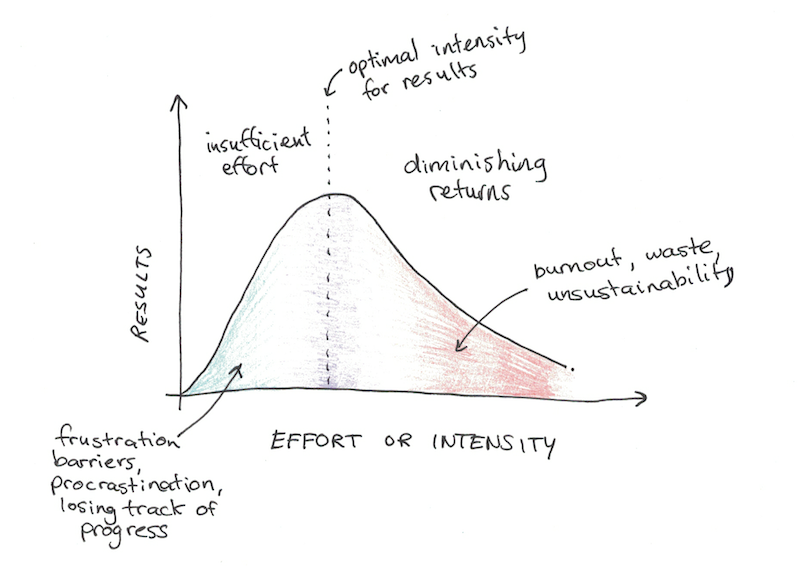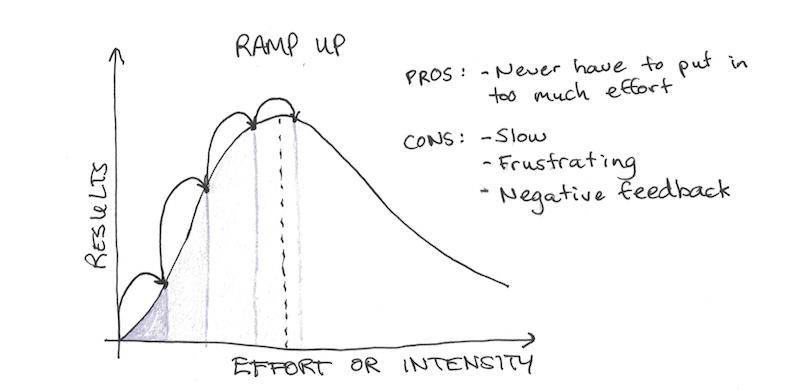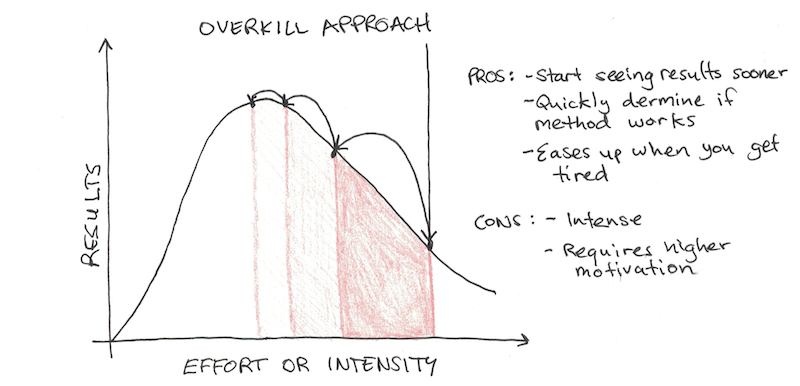Do a search online for any kind of “how to” question, and what do you notice?
Most, if not all, of the searches you’ll do will lead to answers that explain “what” you should do. Which method you should use, where to do it, what materials, etc.
Far less of the advice will focus on what is, for your hardest problems, the most important information. Namely, “how much” of something you should do.
Consider trying to learn a language. A quick search will give you far too many methods to count:
- Immersion
- Pimsleur
- DuoLingo
- Anki
- Classes online
- etc.
But almost none of these will tell you, “if you want to reach level X in the language, you need to put in Y hours of work.”
Why not? Why does advice focus so much on the what and so little on the how much?
Your Efficiency-of-Effort Curve
Success in many categories of activities in life looks a bit like this:

On the bottom, you have the amount of effort you’re inputting. This could be hours spent, but it could also include the intensity spent (compare a light jog to sprinting).
On the y-axis, we have the efficiency of input. This is how much each unit of effort translates into results achieved.
There’s three things you’ll notice:
- First, many pursuits exhibit a certain minimum input to get things going. This is often because putting in a certain amount of effort reaches the “seriousness” threshold required to have you think about it enough for it to create changes in your other behavior.
- ?Too much effort, may also be less effective. If your amount of studying causes you to lose sleep, for instance, or your workout regimen doesn’t give your muscles time to recover, you’ll end up wasting a lot of energy.
- Hitting the efficient point is important. Too little and you may never see results (or too slowly to notice). Too much and you may burnout long before any permanent progress has been made.
Success doesn’t just require determining the right method. It also depends crucially on locating this peak of maximum efficiency. This is the zone where overcoming your hardest problems is going to be easiest, and you can make the most progress on your goals.
Determining the Effective Dose
There are two challenges with determining the effective dose.
First, is that peak efficiency isn’t the same for each person and each situation. It’s going to depend not only on what method you’re using, but also your environment, habits, personality and all sorts of factors that make it hard to say exactly what the optimal intensity is.
This is why so there is much less proffered advice on intensity and much more on method. Methods are relatively universal, the efficiency-of-effort curves, much less so.
Second, is that you can’t know your where your most efficient effort will be in advance. Until you actually start trying to solve your problems or working on your goals at different levels of seriousness and intensity, you just have a guess at what amount of effort is ideal.
The Overkill Strategy
Your problem is to figure out what is an effective dose of effort to solve a problem, except you’re not quite sure what your curve looks like. What should you do?
One strategy is to ramp up. This means keep putting in more seriousness until you’re able to solve the problem. Start small and keep increasing it until you see results.
Trying to learn a language? Start with 5 minutes a day of DuoLingo. That didn’t work? Next try twenty minutes. Then an hour. Then try some actual speaking practice. And so on.

The problem with a ramp-up strategy is it can be quite frustrating. If your starting point is far from the optimal point on the curve, you may have many sputtered attempts to start a habit, fail, and then restart at a higher threshold. This can be demoralizing if you feel like you can’t make progress.
An alternative, which I recommend, is to do the opposite. Start at a point of effort that you believe is almost certainly above the optimal point on the curve. Put in an intense amount of effort, start seeing some results, and then dial down the intensity.

This works well for two reasons. First, it tends to create some success early on, so you can be motivated to keep working. Second, it fits our natural motivational rhythms. You start out intensely, but as you keep working, you’ll naturally relax a bit and become less strict.
How You Can Apply the Overkill Strategy to Solve Your Toughest Problems
How can you apply this right now to the challenges you’re facing?
1. Pick the goal you’re working on.
Decide what you’re trying to achieve. Learn a language? Lose weight? Get a promotion? Build a business? Figure out the outcome you’re trying to reach and what would count as progress towards it.
2. Choose a level of intensity that is at or near your maximum.
You don’t need to sustain this forever. Just long enough to see results and convince yourself that the optimal point lies somewhere beneath it. A good rule of thumb I like to use is to pick a level of intensity I could comfortably sustain for 1-3 months. If I can only sustain it for a week, that may not be enough time to see any fruits of my labors. However, if I’m picking something I know I can sustain indefinitely, I may still be below the threshold on the curve.
3. When you see results, ease back in a controlled fashion.
Once you start seeing results, now’s the time to switch gears and focus on sustainability. This would be a habit which could maintain a level of intensity you’re comfortable with, but for much longer.
What could you use the overkill method on? Which problems are you struggling with because your effort isn’t at the optimal intensity? Share your thoughts below!

 I'm a Wall Street Journal bestselling author, podcast host, computer programmer and an avid reader. Since 2006, I've published weekly essays on this website to help people like you learn and think better. My work has been featured in The New York Times, BBC, TEDx, Pocket, Business Insider and more. I don't promise I have all the answers, just a place to start.
I'm a Wall Street Journal bestselling author, podcast host, computer programmer and an avid reader. Since 2006, I've published weekly essays on this website to help people like you learn and think better. My work has been featured in The New York Times, BBC, TEDx, Pocket, Business Insider and more. I don't promise I have all the answers, just a place to start.